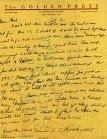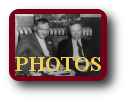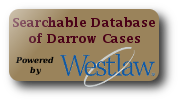Illinois Cases
Clarence Darrow practiced law in Chicago for nearly fifty years. Besides his many famous cases he also participated in many less well-known but interesting cases in Illinois, with the majority of these being in Chicago. This section provides information, documents and photos about some of these less well-known cases from Illinois. Darrow was also influenced by the 1886 Haymarket case and information and material is provided about that case.
|
Brief for the State of Illinois.
August Spies et al. vs. The People of the State of Illinois (Abstract of Record) Volume 1 (1887).
Appeal of the Haymarket defendants.
August Spies et al. vs. The People of the State of Illinois (Abstract of Record) Volume 2 (1887).
People v. Unger (1900).
Various documents related to the case of August M. Unger, a medical doctor, who concocted a plan with one of his patients, Marie Defenbach, to defraud insurance companies. Unger's plan was that the girl should insure her life for large sums of money and later he would give her a drug which would make her appear desperately ill and lapse into a coma simulating death. After Defenbach was declared dead another body would be secured and quickly cremated. Unger would issue the necessary death certificate and collect the insurance money. But something went very wrong and Defenbach died on August 25, 1900 under suspicious circumstances. Unger, Francis W. Brown, and Frank H. Smiley were arrested and charged with conspiracy to defraud various insurance companies. During the investigation it was discovered that Doctor Unger's brother died in New York in September of 1899 under similar circumstances. Smiley, who was a detective, pled guilty and turned state's evidence. The trial of Unger and Brown began on May 21, 1901. Clarence Darrow defended Brown. The defendants were convicted on June 10, 1901 and given indeterminate sentences. Unger's appeal was denied and he was sentenced to five years in prison. Darrow was able to convince the judge that Brown was less culpable than Unger and with the consent of the state's attorney, the verdict was set aside, and a judgment entered sentencing Brown to pay a fine of $2,000.
Chicago & N. W. Ry. Co. v. Eleanor B. Weeks (1902).
Darrow & Thompson represented the appellee, a woman who was injured by a train. A jury verdict in favor of the appellee was overturned in this appellate court opinion.
Hays v. St. Paul M.E. Church, 196 Ill. 633, 63 N.E. 1040 (Ill. 1902).
Injunction by Nellie King Hays against the St. Paul Methodist Episcopal Church and others over a deed conveying property to the church. Altgeld, Darrow & Thompson, for appellees.
West Chicago St. R. R. Co. v. Callow, 102 Ill.App. 323 (1902).
Callow was struck and killed by a car of the West Chicago St. Railroad company. Railroad appealed $4,000 damages award. Altgeld, Darrow & Thompson, attorneys for appellee.
The Chicago City Railway Company v. John Tuohy, 196 Ill. 410 (1902).
In this personal injury case involving a young boy who was hit and seriously injured by an electric car, Altgeld, Darrow & Thompson, and P.A. Hines argued for the appellee boy.
Burke v. Snively, 208 Ill. 328 (1904).
Darrow & Masters argued for the appellant in this suit against government officials.
Meat v. Rice (1904).
A pamphlet by Samuel Gompers on Asian workers entitled Meat vs. Rice: American Manhood Against Asiatic Coolieism, Which Shall Survive?
Brenock v. Brenock, 230 Ill. 519 (1907).
This case involved the interpretation of a will. Darrow, Masters & Wilson argued for the appellee.
VanCleef v. City of Chicago, 240 Ill. 318 (1909).
VanCleef successfully sued the city of Chicago because she was injured during a merchant's carnival and street fair. She was represented by Darrow, Masters & Wilson in this appeal and her verdict was affirmed.
Chudnovski v. Eckels, 232 Ill. 312, 83 N.E. 846 (1908).
Action of assumpsit to recover damages for personal injury. Issue on appeal was whether or not the municipal court of Chicago had jurisdiction of the subject-matter. Darrow, Masters & Wilson for appellee.
Carlin v. Peerless Gas Light Co., 283 Ill 142 (1918).
Darrow, Masters & Wilson, and Jacob L. Baily represented the defendant in error in this suit over damages for a wrongful death.
O'Brien v. Int. Ladies' Garment Workers' Union, 214 Ill. App. 57 (1919).
Two cases involving criminal contempt for violating a labor injunction during a strike. Darrow & Sissman and Yarros of counsel. The second case is O'Brien v. Int. Ladies' Garment Workers' Union, 214 Ill. App. 61 (1919).
Address of Clarence Darrow in the Trial of Arthur Person (1920).
Clarence Darrow's closing argument to the jury in the trial of Arthur Person. Person was charged with joining an organization that called for the violent overthrow of the government, and was acquitted of this charge. Darrow's argument is followed by the jury instructions.
Argument in Defense of the Communists (1920).
Clarence Darrow and co-counsel defended twenty members of the Communist Labor party who were charged with violating a recently passed Illinois statute which made it unlawful to advocate the reformation or overthrow by violence or other unlawful means of the representative form of government secured to citizens of the United States and the states. They appealed, and Darrow participated in the appeal before the Supreme Court of Illinois. Their convictions were upheld in People v. Lloyd, 304 Ill. 23, 136 N.E. 505 (1922).
Clarence Darrow, W. C. Goudy, and A. W. Pulver argued for the appellant Railway Company in this personal injury case. On appeal, a verdict for the appellee was reversed because of erroneous jury instructions, improper admission of a dissenting opinion, and improper exclusion of a different decision.
Crosby v. People, 189 Ill. 298, 59 N.E. 546 (1901).
Marjorie Crosby was a widow facing eviction. When deputies came to serve a writ of assistance to evict her, Crosby's 13-year-old adopted son shot and killed a deputy sheriff with a revolver. The trial, which began in April of 1899, was big news in Chicago. Clarence Darrow and William Prentiss, a former judge, defended the Crosbys. Even though she did not shoot the victim, Marjorie Crosby was convicted of manslaughter. The Supreme Court of Illinois held that there was insufficient evidence to sustain a conviction of manslaughter for having aided, abetted, or assisted in the killing. Clarence S. Darrow and William Prentiss, for plaintiff in error.
People v. Belinski, 205 Ill. 564, 69 N.E. 5 (1903).
Clarence Darrow and Edgar Lee Masters defended Belinski, a lawyer who was disbarred for falsely representing to his client that he had obtained a divorce for the client by showing him a fictitious divorce decree. The disbarment was upheld in this appeal.
Carlin v. City of Chicago, 177 Ill. App. 89 (1913).
Clarence Darrow and Francis S. Wilson represented the plaintiff in error in this suit over the wrongful death of six-year-old child.
People v. Bond, 281 Ill. 490 (1917).
Isaac Bond was a black man convicted for murdering a white woman and sentenced to life in prison. Clarence Darrow and two other lawyers unsuccessfully appealed his conviction.
People v. Rappaport 364 Ill. 238, 4 N.E.2d 106 Ill. (1936).
Appeal of 30 year old Joseph Rappaport, the son of a rabbi, who was convicted of murder and sentenced to death for killing a government informant in a narcotics case. Rappaport was represented by Clarence Darrow, William W. Smith, William L. Carlin, and Edward M. Keating in this appeal. The Supreme Court of Illinois affirmed the conviction and sentence. His execution was delayed numerous times by Governor Horner. The day before the latest execution date, Governor Horner announced that he would consider a further reprieve if Rappaport submitted to a polygraph test which Horner placed great faith in. On March 2, 1937, just hours before Rappaport was to be executed, a polygraph machine was taken to his death cell. It was administered by Leonarde Keeler, co-inventor of the polygraph and the first full-time professional polygraph examiner. Keeler was also a friend of Governor Horner. Keeler announced that Rappaport had failed the test and he was executed in the electric chair two hours later.
Statement by Illinois Governor Dunne about a pardon for a client of Clarence Darrow.
The Hart Schaffner & Marx Labor Agreement: Being a Compilation and Codification of the Agreements of 1911, 1913 and 1916 and Decisions Rendered by the Board of Arbitration (1916).
In 1910, about 40,000 clothing workers who toiled in Chicago's men's clothing industry went on strike for nineteen weeks. The focus of the strike was Hart, Schaffner and Marx, the largest company that refused to join the Chicago Wholesale Clothiers Association (an organization of large firms). The strike began when several women workers refused to take a cut in pay and walked out. This quickly ignited a large strike. Eventually an agreement was reached by representatives of the workers and Hart, Schaffner and Marx on March 13, 1911. The agreement was a compromise between the United Garment Worker's (UGW) demand for a closed shop and management's demand for an open shop.
The agreement setup an arbitration board to rule on shop grievances. Clarence Darrow represented the workers and Carl Meyer represented the company. Dean John Wigmore of Northwestern Law School was chosen as an impartial chairman but he was unable to serve, leaving Darrow and Meyer to work out the issues between them. Darrow's law partner, William O. Thompson, took his place when Darrow went to Los Angeles to defend the McNamara brothers who were arrested after the bombing of the Los Angeles Times building in October 1910. The clothing workers strike led to the formation in 1914 of the Amalgamated Clothing Workers of America which was led by Sidney Hillman.
Article critical of Governor Altgeld's pardon of the Haymarket anarchist. Published in volume 5 of The Green Bag.
Current Topics - The Albany Law Journal (1896).
Article responding to Governor Altgeld's criticism of some courts and judges.
The Iroquois Theater Cases (1907).
Two articles from the Illinois Law Review about the Iroquois Theater litigation. One article is very critical about the length of the litigation--"A Flagrant Instance of the Law's Delays"--while the other tries to explain why it has taken this much time--"Another View."
This pamphlet includes a preface by Lucy E. Parsons, whose husband Albert Parsons was executed for the Haymarket bombing.
This article describes the political success and campaign techniques of Chicago's First Ward Alderman John Coughlin, along with the unsuccessful attempt of David L. Frank to oust Coughlin from office. Coughlin went to great lengths to garner votes and care for his supporters, even providing lodging and food before the election.
Clarence Darrow and Other Attorneys Defend Lewis Thombs (1902).
Published in The Public.
Movement to Make Clarence Darrow a Candidate for Mayor (1902).
Discussion of Clarence Darrow's decision not to run for Mayor of Chicago as an independent candidate. Published in The Public.
Public Ownership Party Nominates Clarence Darrow (1902).
Brief announcement that Clarence Darrow had been nominated as a candidate for the Illinois legislature. Published in The Public.
How Chicago is Finding Herself by Ida M. Tarbell (1908).
This article is about Chicago under Mayor Edward F. Dunne's leadership. It includes references to Clarence Darrow, who quarreled with the mayor and resigned as special traction counsel.
Chicago Husband-Killing and the "New Unwritten Law" by Marianne Constable (2006).
Discusses why so few women who killed their husbands in Chicago between 1870 and 1930 were convicted of murder. It appears that a "new unwritten law" protected many women from being convicted. Also discusses the murder case of Emma Simpson who shot and killed her husband in April 1919 in a crowded Chicago courtroom during alimony proceedings. The couple was separated at the time but Emma Simpson refused to divorce him. She declared that she would be acquitted and stated "the new unwritten law, which does not permit a married man to love another woman, will be my defense." Clarence Darrow defended her and said to the all-male jury: "You've been asked to treat a man and a woman the same - but you can't. No manly man can." The jury found Emma Simpson to be insane and guilty. Published in TriQuarterly no. 124 (2006), 85-96.
News account in the San Francisco Call about a 1903 railway strike in Chicago in which Clarence Darrow represented the strikers. Includes a small picture of Darrow.
This 1883 publication describes Chicago's founding and many aspects of the city, including early modes of transportation, commerce, and theater.
Anarchy and Anarchists (1889).
"A History Of The Red Terror And The Social Revolution In America And Europe. Communism, Socialism, And Nihilism In Doctrine And In Deed. The Chicago Haymarket Conspiracy, And The Detection and Trial of the Conspirators." Written by Chicago Police Captain Michael Schaack, who played a prominent role into the investigation of the Haymarket bombing.
Reasons for Pardoning Fielden, Neebe, and Schwab, the So-Called Anarchists, June 26, 1893.
This excerpt from Governor Altgeld's book, Live Questions, explains his justification for pardoning the remaining Haymarket Anarchists.
The Chicago Martyrs by John P. Altgeld (1899).
This book contains speeches, given by the Haymarket Anarchists in Judge Gary's courtroom, requesting a new trial. It also contains Governor Altgeld's reasons for pardoning the three who were not executed.
Live Questions, by John Peter Altgeld (1899).
John Peter Altgeld became Clarence Darrow's friend and mentor soon after Darrow moved to Chicago. This book contains Altgeld's views on numerous social issues and his reasons for actions he took as governor of Illinois.
"Lest We Forget" Chicago's Awful Theater Horror, By the Survivors and Rescuers (1904).
Account of the Iroquois Theater fire on December 30, 1903 which killed 602 people. Most the victims were women and children. Numerous safety violations were uncovered after the tragedy. Clarence Darrow worked behind the scenes for several of the defendants who faced criminal charges. No one was ever convicted and because the company was insolvent the victims' families were not compensated.
Chicago Traction: A History Legislative and Political by Samuel Wilbur Norton (1907).
Norton discusses a political and legal battle over municipal ownership of the Chicago street car (traction) system. Several references are made to Clarence Darrow. At one point, Darrow and another attorney were appointed special counsel on traction for the city of Chicago.
People vs. Spies et al.: The Chicago Anarchist Case (1907).
Chapter from Decisive Battles of the Law covering the Haymarket case from a book about eight important cases. Clarence Darrow closely followed the Haymarket case.
Decision on the Freedom of the Press (1916).
Chapter from the book Dunne: Judge, Mayor, Governor which discusses a case in which Clarence Darrow and others defended two editors from the Chicago American newspaper facing a contempt of court order by Judge Hanecy.
50 - 50 Fighting Chicago's Crime Trusts by Henry B. Chamberlin (1916).
The first chapter of this book called "Arson Trust" describes a major arson investigation in Chicago. Clarence Darrow defended at least one of the defendants arrested for arson after this investigation. In 1912 Paul and Edward Covitz, two brothers who were also woolen merchants, approached Joseph Clarke, a public insurance adjuster, who was also part of a nationwide arson ring to torch their business. Clarke arranged this but the fire that was set on the night of November 5, 1912 was obviously arson and the three were arrested and indicted by a Cook County grand jury in April 1913 for arson and burning to defraud. The arsonist was also arrested. Just three days after he was arrested, Clarke tried to bribe one of the assistant state's attorneys to quash the proceedings before the grand jury. Clarke was arrested for this bribery attempt. Darrow most likely defended Clarke because Darrow is named as counsel for Clarke on his appeal. During the trial, evidence of Clarke's bribery attempt was ruled admissible to show that Clarke was in the conspiracy with the Covitz brothers and equally guilty with them of causing the fire. The defendants were convicted by a jury in August and sentenced to the Joliet penitentiary. Their convictions were upheld by the Supreme Court of Illinois in People v. Covitz, 262 Ill. 514, 104 N.E. 887 (Ill. 1914).
The Clothing Workers of Chicago: 1910-1922.
Published by the Chicago Joint Board, Amalgamated Clothing Workers of America, the book makes several references to Clarence Darrow's work on the Hart, Schaffner and Marx labor agreement.
The Negro in Chicago: A Study of Race Relations and a Race Riot (1922).
Report on the Chicago Race Riot of 1919 in which fifteen whites and twenty-three blacks were killed in July and August 1919. Written by the Chicago Commission on Race Relations. A reference is made to Clarence Darrow being an honorary member of the Chicago Free Thought Educational Society on p. 541.
Tennes As A Vice Chief (1929).
Chapter from the Illinois Crime Survey, a massive report of over 1100 pages, published in 1929. This chapter titled "Tennes As A Vice Chief" is about a violent Chicago gangster named Jacob "Mont" Tennes. In 1907 Tennes had acquired a very lucrative business when he took over a wire service that transmitted the results of horse races that bookies needed. Tennes demanded Illinois bookies to pay him half of their daily take and there were more than 700 bookies in just Chicago. But other gangsters wanted in on such a profitable enterprise and Tennes' home was bombed 6 times from July to September 1907. Mont Tennes was so successful that his activities prompted Judge Kenesaw Mountain Landis of the United States District Court, Northern District of Illinois, to launch an investigation. Judge Landis issued subpoenas and also requested the cooperation of Illinois Bell Telephone in the investigation. On October 2, 1916, Tennes, without a subpoena, was surrendered by his special counsel, Clarence Darrow. Tennes took Darrow's advice and refused to answer incriminating questions. But others who knew of Tennes operations reluctantly testified that the General News Bureau, with Tennes owning 65%, made $20,000 to $25,000 per month profit but kept absolutely no paperwork of its business. But Judge Landis ended the investigation when he concluded local gambling was not within the jurisdiction of the federal courts and the interstate transmission of sporting news was not a crime. In 1921, Judge Landis was appointed to be the first commissioner of Major League Baseball and he served as commissioner until 1944.
1899 bio of Edgar Lee Masters who would become Clarence Darrow's law partner in 1903. Published in The Bench and Bar of Illinois.
The Chicago Traction Question by Clarence S. Darrow.
Darrow advocates municipal control of the street railways in Chicago in this article. Vol. XII, The International Quarterly (1905-1906).
Proceedings of the Illinois State Bar Association.
Thirtieth Annual Meeting, Chicago, July 12 and 13, 1906. Several references are made to Clarence Darrow. In particular, Darrow discussed his views in support of Public Ownership.
Elbridge Hanecy (1908).
Short bio of Elbridge Hanecy. In 1901, Clarence Darrow, John P. Altgeld and co-counsel represented several editors of the Chicago American newspaper after they were jailed for contempt of court by Judge Hanecy who was angry because the paper criticized a court decision he made.
Edgar Lee Masters (1916).
Short bio of Edgar Lee Masters published in Courts and Lawyers of Illinois.
Clarence Darrow bio in Courts and Lawyers of Illinois (1916).
Short biography of Clarence Darrow.
Experience of Hart, Schaffner and Marx with Collective Bargaining by Earl Dean Howard (1917).
Howard was the Director of Labor for Hart, Schaffner and Marx and Professor of Economics at Northwestern University.
Hart Schaffner & Marx Labor Agreement: Industrial Law in the Clothing Industry (1920).
Labor agreement following a nineteen-week strike of workers in the Chicago mens' clothing industry in 1910. The agreement setup an arbitration board to rule on shop grievances. Clarence Darrow represented the workers. The agreement, signed by representatives of the workers and Hart, Schaffner and Marx was a compromise between the United Garment Workers (UGW) demand for a closed shop and management's demand for an open shop.
William L. Carlin bio in The Bench and Bar of Illinois (1920).
William Carlin practiced law with Clarence Darrow and Peter Sissman.
Edward Brundage (1920).
Short bio of Edward Brundage, Attorney General of Illinois. Clarence Darrow faced Brundage in court including during his defense of Isaac Bond, a black man convicted of murdering a white women.
Clarence Darrow bio in The Bench and Bar of Illinois.
Short bio and picture of Clarence Darrow published in 1920.
Photos
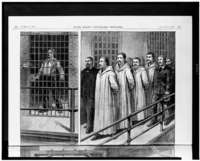 The Law Vindicated - Four of the Chicago Anarchists Pay the Penalty of Their Crime Albert Parsons, August Spies, Adolph Fisher, and George Engel being led to their execution. Frank Leslie's Illustrated Newspaper, 1887 Nov. 19, p. 217. Library of Congress Prints and Photographs Division, LC-USZ62-109367. |
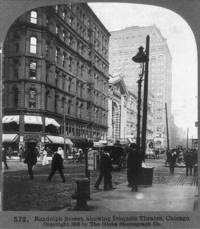 Randolph Street, showing Iroquois Theatre, Chicago c. 1905. Library of Congress Prints and Photographs Division, LC-USZ62-51774. |
 Haymarket Memorial in Waldheim Cemetery, Chicago. Large memorial to 4 anarchists executed after the Haymarket bombing. Part of William Haywood''s ashes were scattered here. Library of Congress Prints and Photographs Division, LC-USZ62-61671. |
 Proclamation on Labor by the President of the United States of America. President Ulysses S. Grant's proclamation directing that wages not be reduced on account of a reduction in work hours instituted in 1868. Library of Congress Prints and Photographs Division, LC-DIG-ppmsca-12629. |
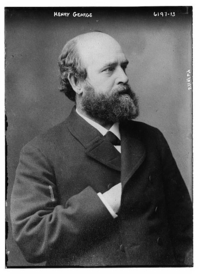 Henry George. Clarence Darrow became an ardent supporter of Henry George and his "single tax" policy after reading George's 1879 book Progress and Poverty which made him famous and started a political movement in the United States built around his work. George later almost won election as mayor of New York. George believed government should be funded only from a "single tax" levied on the unimproved value of land. This would be the value of the land in its natural state without any man-made improvements such as buildings. This was not an entirely new concept as George borrowed from the works of David Ricardo, James Mill, and John Stuart Mill. George was enormously popular in Britain. Darrow joined the Single Tax Club soon after arriving in Chicago. Library of Congress Prints and Photographs Division, LC-DIG-ggbain-37132. |
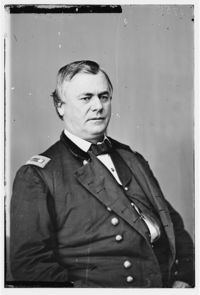 Richard J. Oglesby, between 1860 and 1870. Richard J. Oglesby (1824 - 1899) served as governor of Illinois from 1865 and 1869 and was elected again in 1884. Clarence Darrow wrote in his autobiography in regard to the Haymarket bombing that Oglesby "was a former general in the Civil War and had been prominent in politics for many years. After giving consideration to all the petitions he commuted the sentences of Fielding and Schwab to imprisonment for life, but Parsons, Spies, Engel and Fischer were hanged; and Lingg, a boy about twenty-one, managed to get a percussion cap of some sort which he put into his mouth, exploded it, and thus tore his head to pieces." Library of Congress Prints and Photographs Division, LC-DIG-cwpb-05642. |
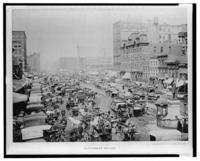 Haymarket Square, c. 1893. Haymarket Square about seven years after the Haymarket bombing. LC-USZ62-134212, Library of Congress Prints and Photographs Division. |
 Passenger Terminal, Chicago and Northwestern Railway. In 1891, Clarence Darrow accepted a part-time position in the legal department of the Chicago & Northwestern Railway Company. Library of Congress Prints and Photographs Division. |
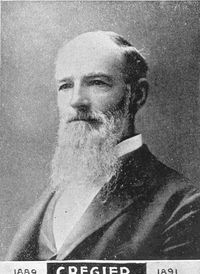 DeWitt Clinton Cregier. DeWitt Clinton Cregier (1829 - 1918) served as the mayor of Chicago from 1889 to 1891. In 1889, Cregier saw Clarence Darrow give a speech on free trade and afterward he offered Darrow the position of Special Assessment Attorney for the city of Chicago. He told Darrow that he offered him the position because of his speech but Darrow found out later that John Peter Altgeld had asked Cregier to offer Darrow a position in the city government. Courtesy of UCR/California Museum of Photography. |
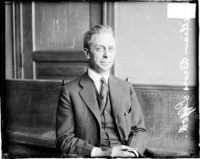 William Bross Lloyd. A millionaire from Winnetka, Illinois, and one of the organizers of the Communist Labor Party. William was the son of Henry Demarest Lloyd, a friend of Clarence Darrow. Clarence Darrow and co-counsel defended Lloyd and about nineteen other members of the Communist Labor party in 1920 who were charged with violating an Illinois law that prohibited advocating by violence or other unlawful means the overthrow of a representative form of government. Chicago Daily News negatives collection, DN-0072195. Courtesy of the Chicago Historical Society. |
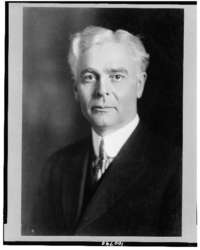 Ole Hanson, Mayor of Seattle. In 1920, Clarence Darrow defended twenty members of the Communist Labor party who were charged with violating an Illinois statute that made it unlawful to advocate reformation or overthrow of the existing form of government by violence or other unlawful means. The defendants were convicted and their convictions were upheld by the Illinois Supreme Court. Ole Hanson was one of the main witnesses against the defendants in regard to a general strike in Seattle February 6, 1919. The strike was composed of members of the Metal Trades Council and the Central Labor Council of Seattle and according to the Illinois Supreme Court opinion about the case the goal of the strike was to tie up transportation and the supply of food, light, heat, and other necessities, thereby compelling the civil authorities to surrender the government of the city of Seattle to this committee; that the body proposed to organize a soldiers', sailors', and workingmen's council to take over the city government; that the Union Record was the official newspaper of organized labor in Seattle, and that it carried propaganda of this character; that about 20,000 circulars entitled, “Russia Did It.” People v. Lloyd, 136 N.E. 505 (Ill. 1922). Library of Congress Prints and Photographs Division, LC-USZ62-100790. |
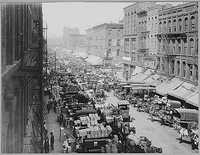 Chicago, 1915. Looking west on South Water Street, Chicago, crowded with horse-drawn wagons and motor trucks filled with produce for market. National Archives and Records Administration ARC Identifier: 521051. |
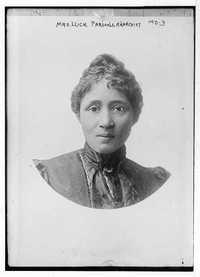 Mrs. Lucy Parsons. Lucy Parsons, who was part Native American, African-American and Mexican, was an anarchist labor activist and the wife of Albert Parsons one of the Haymarket defendants who was hanged. Library of Congress Prints and Photographs Division, LC-DIG-ggbain-00827. |
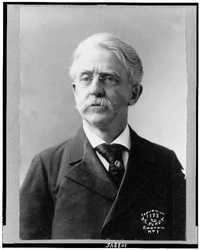 Henry Demarest Lloyd. In 1920 Clarence Darrow and several other attorneys defended twenty members of the Communist Labor party arrested and charged in Illinois with advocating the forceful overthrow of the government. One of the defendants was William Bross Lloyd, referred to as the "millionaire Communist" because he was the son of Darrow's friend Henry Demarest Lloyd who was very wealthy. Their trial took place from June to August 1920 in the Criminal Court in Cook County. They were convicted for violating an Illinois statute that made it unlawful to advocate reformation or overthrow of the existing form of government by violence or other unlawful means. They were sentenced to various terms of one to two years and fined. Darrow and co-counsel participated in their appeal before the Illinois Supreme Court but the court upheld the convictions. Library of Congress Prints and Photographs Division, LC-USZ62-103845. |
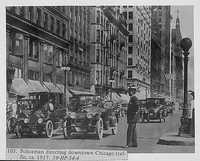 Downtown Chicago, ca. 1917. Policeman directing downtown Chicago traffic, ca. 1917 National Archives and Records Administration, ARC Identifier: 518065. |
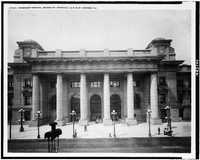 Passenger Terminal, Madison St. Entrance, Chicago and North Western Railway Company, Chicago, Ill. c. 1912. Library of Congress Prints and Photographs Division, LC-USZ62-101582. |
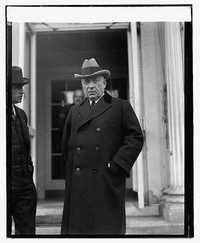 Frank O. Lowden. Frank Lowden was the governor of Illinois from 1917 to 1921. In 1896 at the 20th Annual Meeting of the Illinois State Bar Association, Clarence Darrow was one of numerous attorneys recommended for membership by the committee on admissions. Others also recommended included Edgar Lee Masters, Frank O. Lowden, and Kenesaw Mountain Landis. In 1928 Darrow wrote an article titled "Frank Lowden, the Farmer's Friend" that was published in Scribner's Magazine. Library of Congress Prints and Photographs Division, LC-DIG-npcc-10083. |
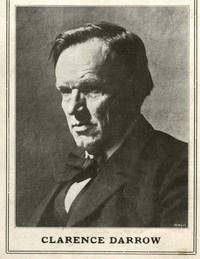 Clarence Darrow. Cover of pamphlet of one of Clarence Darrow's numerous debates. |
 Giants vs. Cubs, National League Park, Chicago, August 30, 1908. Clarence Darrow was a lifelong baseball fan and a loyal Chicago Cubs fan; as an adult he would read the baseball scores before moving on to other stories in the newspapers. Library of Congress Prints and Photographs Division, pan 6a29710 http://hdl.loc.gov/loc.pnp/pan.6a29710. |
 Iroquois Theater After the Fire, Dec. 31, 1903. The Iroquois Theater in Chicago caught fire December 30, 1903 during a performance killing 602 people. Most the victims were women and children. This is at least twice as many deaths as was caused by the Great Fire in Chicago in 1871. As of 2009 it is still the deadliest single-building fire in the history of the United States. In terms of number of deaths from a building complex, it is surpassed only by the collapse of the World Trade Center buildings on September 11, 2001. There was a nationwide uproar to hold the theater owners and city officials accountable. Legal action was started very soon after the disaster with criminal charges filed and 272 civil lawsuits against the Iroquois Theater Company but the company was insolvent and the relatives of the victims went uncompensated. Clarence Darrow worked behind the scenes to have the criminal charges against several of the defendants dismissed. No one was sent to prison. Library of Congress Prints and Photographs Division, LC-DIG-ppmsca-07431. |
 Panorama of A Century of Progress Exposition, Chicago, 1933. Chicago had grown and changed considerably since Clarence Darrow moved there in 1887. Library of Congress Prints and Photographs Division, LC-USZ62-126465. |
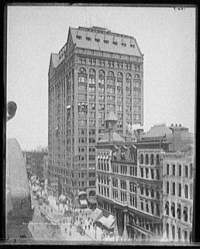 Unity Building and Dearborn Street, Chicago c. 1906. Library of Congress Prints and Photographs Division, LC-USZ62-71891. |
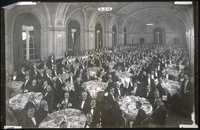 Illinois State Bar Association Banquet for Justices of the Supreme Court of Illinois. Hotel LaSalle, Chicago, c. Oct. 30, 1909. Library of Congress Prints and Photographs Division, pan 6a27028. |
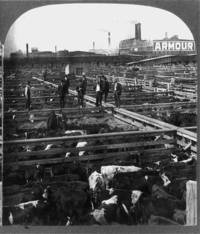 In the Heart of the Great Union Stock Yards, Chicago, c. 1909. Library of Congress, Prints and Photograph Division, LC-USZ62-97324. |
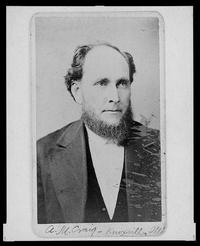 Alfred M. Craig, Illinois Supreme Court Judge [between 1870 and 1880]. Library of Congress Prints and Photographs Division, LC-USZ62-135577. |
 Ellen Gates Starr. Ellen Gates Starr (1859 - 1940) was an American social reformer and activist. She was a co-founder of Hull House in Chicago which was formed to provide social and educational opportunities for the poor. Starr knew Clarence Darrow through her work at Hull House. Library of Congress Prints and Photographs Division, LC-DIG-ggbain-23460. |
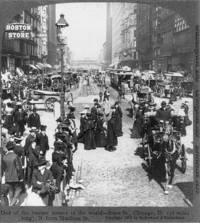 "One of the busiest streets in the world" State Street, Chicago. |
 Michigan Avenue, Chicago c. 1910. Library of Congress Prints and Photographs Division. |
 Ore Docks, Blast Furnaces & Steel Mills, South Chicago, Ill., International Harvester Co. Library of Congress Prints and Photographs Division, LC-USZ62-41402. |
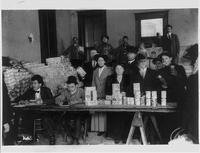 Commissary - Chicago Garment Workers Strike. In 1910, about 40,000 clothing workers in Chicago's men's clothing industry went on strike for nineteen weeks. The focus of the strike was Hart, Schaffner and Marx, the largest company that refused to join the Chicago Wholesale Clothiers Association (an organization of large firms). An agreement was reached by representatives of the workers and Hart, Schaffner and Marx on March 13, 1911. The agreement setup an arbitration board to rule on shop grievances. The arbitration board consisted of Clarence Darrow who represented the workers and Carl Meyer who represented the company. The clothing workers strike led to the formation in 1914 of the Amalgamated Clothing Workers of America. Library of Congress Prints and Photographs Division, LC-USZ62-59631. |
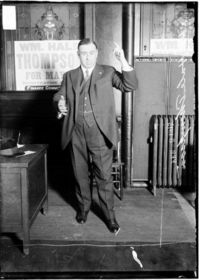 William Hale Thompson. William Hale Thompson (1869 - 1944) served as mayor of Chicago from 1915 to 1923 and again from 1927 to 1931. Thompson was the last Republican to be elected mayor of Chicago. Known as "Big Bill" his administration became notorious for corruption. To appeal to Irish voters, Thompson promised that if King George of England ever dared set foot in Chicago he would "punch him in the snout." Thompson was very popular among black voters. During the 1927 campaign, Thompson brought two rats out in cages on a stage and proceeded to debate each rat which represented his opponents. One of the rats was supposed to represent Fred Lundin whom Clarence Darrow helped defend from corruption charges. Thompson was angry at Lundin for backing his opponent. Clarence Darrow defended several clients who were part of the Thompson administration. http://en.wikipedia.org/ wiki/File:William_hale _thompson.jpg |
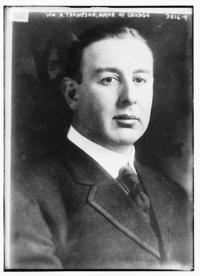 William H. Thompson, Mayor of Chicago. William Hale Thompson was mayor of Chicago from 1915 to 1923 and again from 1927 to 1931. He was born May 14, 1869 and died March 18, 1944. Library of Congress Prints and Photographs Division, LC-DIG-ggbain-19321. |
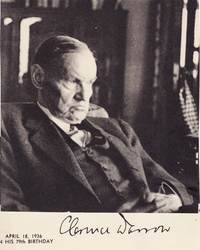 Clarence Darrow on his 79th Birthday, April 18, 1936. |
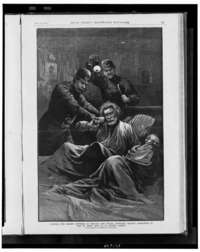 The Police Capturing Leading Anarchists at One of Their Dens after Haymarket Bombing. "Illinois - the recent troubles in Chicago - the police capturing leading anarchists at one of their dens, No. 616 Centre Avenue / from a sketch by C. Bunnell." Frank Leslie's Illustrated Newspaper, v.62, 1886 May 22, p. 217. Library of Congress Prints and Photographs Division, LC-USZ62-121648. |
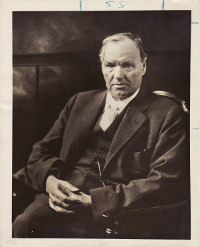 Clarence S. Darrow. |
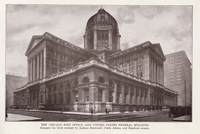 The Chicago Post Office and United States Federal Building. |
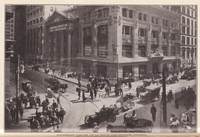 Southeast corner of La Salle and Monroe streets c. 1912. Chicago street scene. |
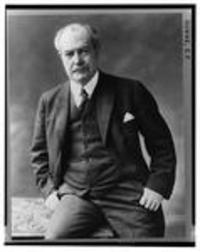 Governor Edward F. Dunne. Edward Dunne (1853 - 1937) was a judge in Cook County, Chicago from 1892 to 1905. As a judge Dunne married Clarence Darrow and Ruby Hammerstrom in 1903. Dunne served as mayor of Chicago for two terms from 1905 to 1907. As mayor he appointed Clarence Darrow as special counsel for traction affairs for the city of Chicago. Both Dunne and Darrow favored municipal ownership of the Chicago street railway system. He served as governor of Illinois from 1913 to 1917. In 1930 he was appointed to serve as an attorney for the Cook County Board of Election Commissioners. Library of Congress Prints and Photographs Division, LC-USZ62-123215. |
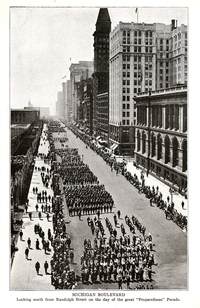 Great Preparedness Day Parade. During the spring and summer of 1916 "Preparedness Day Parades" led by business groups were staged nationwide to try and convince Congress to pass pending bills to increase the size of the military. Organized labor refused to participate despite the urging of Samuel Gompers, president of the American Federation of Labor. While Chicago was one of the centers of the labor movement and the Chicago Federation of Labor opposed the parade and urged union members not to participate, Chicago also had the largest Preparedness Day parade. |
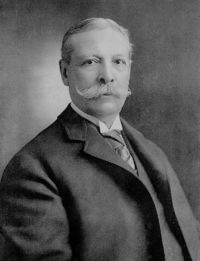 Charles Tyson Yerkes. Charles Yerkes (1837 - 1905) was a financier who was born in Philadelphia and played a major role in developing the mass-transit systems in Chicago and London. Darrow wrote an article in 1906 titled "The Chicago Traction Question" in which he criticized Yerkes's control of the Chicago streetcars. In his autobiography, Darrow wrote "Mr. Yerkes was a man of iron will, and as bold as any buckaneer who ever sailed the financial seas. He and his family have long been dead, or I might not like to make these very moderate statements of fact. For all sentient organisms feel pain, and I always have tried to avoid causing it." The Story of My Life. http://en.wikipedia.org /wiki/File:Yerkes002.jpg |
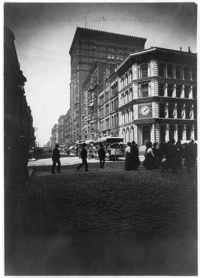 Unity Building and Dearborn Street, Chicago c. 1906. Clarence Darrow's mentor, John Peter Altgeld, became very wealthy through real estate. He had the 16-story Unity Building built in 1891. Clarence Darrow wrote in his 1932 autobiography The Story of My Life that: "During his period of prosperity Altgeld had erected a building sixteen stories high; one of the most expensive and elaborate of the time. It was one of the first of the "sky-scrapers" within what is now "the Loop" in Chicago. He had put into this building all his assets, around six or seven hundred thousand dollars; and had encumbered it by a mortgage of two millions or more. He was always charitable and generous, and saw and did things in a big way. When he became governor and went to Springfield, Ill., the capital of the State, he was not able to give much time to his financial affairs. When he pardoned the anarchists many of his best tenants of the big "Unity" left the building, and it was refilled by young lawyers, radicals and idealists, many of whom could not pay their rent. Any one not able to pay office rent moved to the Unity Building. So Altgeld was obliged to default in his interest, and the bondholders showed him no mercy. In fact, they wanted him to fail. It would be a fine lesson in showing the punishment of evil and the triumph of virtue." Library of Congress Prints and Photographs Division, LC-USZ62-71891. |
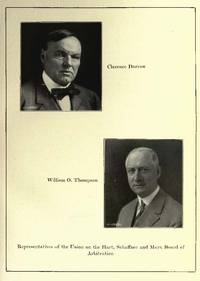 Clarence Darrow and William O. Thompson. Clarence Darrow and William O. Thompson were the two union representatives on the Hart, Schaffner and Marx Board of Arbitration. They were also law partners for several years. |
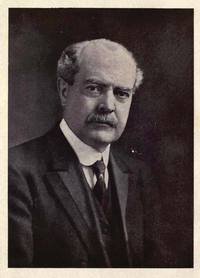 Edward F. Dunne. As a judge, Edward Dunne married Clarence Darrow and his second wife Ruby on July 16, 1903. Edward Dunne later served as mayor of Chicago from 1905 to 1907 and then Governor of Illinois from 1913 to 1917. |
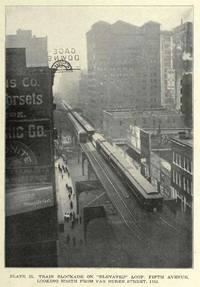 Elevated Loop near Fifth Avenue, Chicago. |
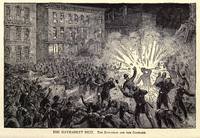 The Haymarket Riot. The Explosion and the Conflict. |
 Chicago Business District 1914. View of business district, looking Northwest from Transportation building. Arrow indicates the La Salle Street Terminal. |
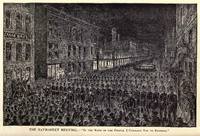 The Haymarket Meeting - "In the Name of the People I Command You to Disperse." Police ordering meeting to disperse just prior to someone throwing a bomb. |
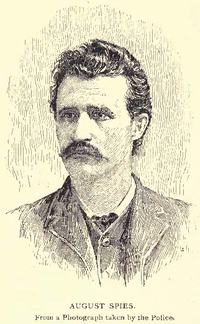 August Spies. One the Haymarket defendants who was executed. |
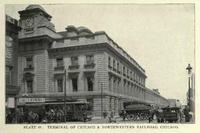 Terminal of the Chicago & Northwestern Railroad, Chicago c. 1914. |
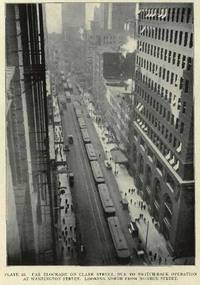 Clark Street, Chicago. |
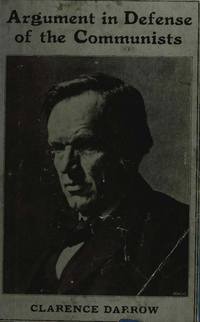 Clarence Darrow. Cover of pamphlet containing Clarence Darrow's argument to the jury in defense of William Bross Lloyd and nineteen others who were charged with violating a recently passed Illinois statute which made it unlawful to advocate the reformation or overthrow by violence or other unlawful means of the representative form of government secured to citizens of the United States and the states. Darrow participated in the appeal before the Supreme Court of Illinois. Their convictions were upheld in People v. Lloyd, 304 Ill. 23, 136 N.E. 505 (1922). |
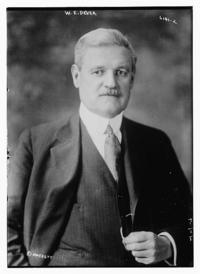 William E. Dever. William Dever was Mayor of Chicago from 1923 to 1927. A committed reformer he enforced prohibition and anti-gambling laws. Library of Congress Prints and Photographs Division, LC-DIG-ggbain-36768. |
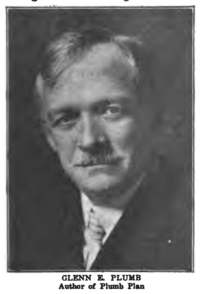 Glenn E. Plumb. Plumb was co-counsel with Clarence Darrow in Blair v. City of Chicago, 201 U.S. 400 (1905). Along with several other lawyers they represented the City of Chicago. Plumb was head of the Plumb Plan League and author of the Plum plan for the nationalization of railroads. He also served as counsel for sixteen large railroad labor organizations. |
 Francis X. Busch. Francis Busch was a close friend of Clarence Darrow. He was one of the founders of the law college at DePaul University and also served as Dean. |
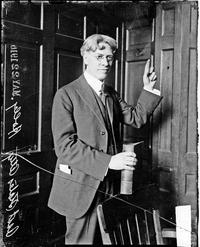 Judge William Holly. Judge William Holly and Clarence Darrow were very good friends. For years they practiced law together in the same firm. As one of his first judicial appointments, President Franklin Roosevelt appointed Holly as a federal judge for the Northern District of Illinois in 1933. Judge Holly gave a eulogy at Clarence Darrow's funeral in 1938. Text on the negative reads assistant state's attorney. DN-0066232, Chicago Daily News negatives collection, Chicago Historical Society. |
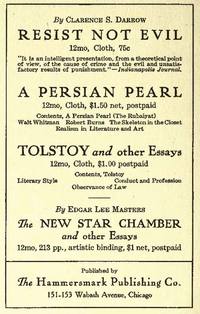 1904 Ad for Books by Clarence Darrow and Edgar Lee Masters. |
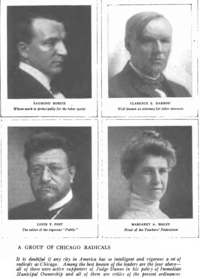 A Group of Chicago Radicals. Clockwise from top: Raymond Robins, works for the labor party, Clarence Darrow, "Well known as attorney for labor interests", Louis F. Post, editor of the Public, and Margaret A. Haley, Head of the Teachers' Federation. Photo from a 1908 article about Mayor Dunne titled "How Chicago is Finding Herself" by Ida M. Tarbell. |
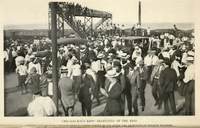 Beginning of Chicago Race Riot. The Chicago Race Riot of 1919 was the worst race riot in Illinois history. It began on July 27, 1919 and ended on August 3. When it was over, 38 people were dead which included 23 African Americans and 15 whites. |
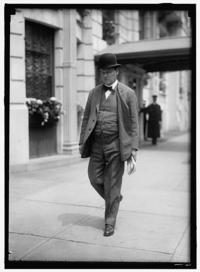 Clarence Darrow in 1915. Library of Congress Prints and Photographs Division, LC-DIG-hec-06039. |
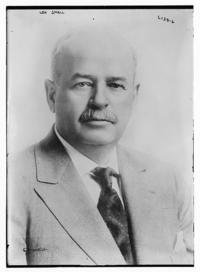 Governor Len Small. On November 30, 1922, Illinois Republican Governor Len Small granted executive clemency to William Bross Lloyd and other communists convicted in a trial in Chicago in 1920. Clarence Darrow defended the men during the trial and also on appeal where their conviction was upheld in People v. Lloyd, 136 N.E. 505 (Ill. 1922). Library of Congress Prints and Photographs Division, LC-DIG-ggbain-36737. |
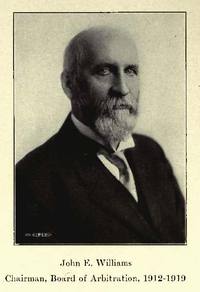 John E. Williams. Hart, Schaffner and Marx Labor Agreement. |
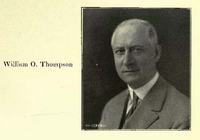 William O. Thompson. As part of the Hart, Schaffner and Marx labor agreement, an arbitration board was setup to rule on shop grievances. Clarence Darrow represented the workers. William O. Thompson, Darrow's law partner, took his place when Darrow went to Los Angeles to defend the McNamara brothers who were arrested after the bombing of the Los Angeles Times building in October 1910. |
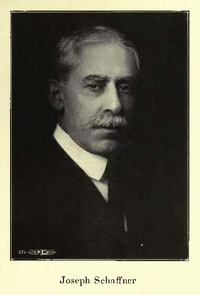 Joseph Schaffner. Joseph Schaffner was a founding member of Hart, Schaffner, and Marx and a trustee of Northwestern University. |
 'Sidney Hillman. Founder of the Amalgamated Clothing Workers of America and president from 1914 to 1946. |
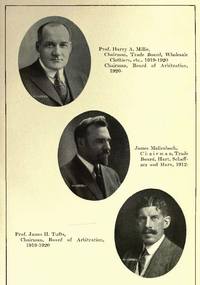 Professor Harry A. Millis, James Mullenbach, Professor James H. Tufts. The Hart, Schaffner and Marx labor agreement followed a nineteen-week strike of workers in the Chicago men's clothing industry in 1910. The agreement setup an arbitration board to rule on shop grievances. Clarence Darrow represented the workers. The agreement, signed by representatives of the workers and Hart, Schaffner and Marx was a compromise between the United Garment Worker's (UGW) demand for a closed shop and management's demand for an open shop. Photo from The Clothing Workers of Chicago, 1910-1922 by Amalgamated Clothing Workers of America (1922). |
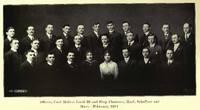 Officers, Coat Makers Local 39 and Shop Chairmen, Hart, Schaffner and Marx. |
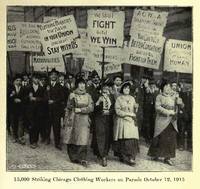 Chicago Clothing Workers strike. |
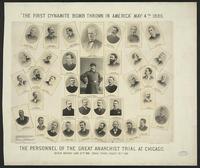 "The First Dynamite Bomb Thrown in America" May 4th, 1886. "The first dynamite bomb thrown in America" May 4th, 1886. The personnel of the great anarchist trial at Chicago. Begun Monday June 21st 1886. Ended Friday, August 20th 1886." "I have examined all the pictures on this sheet and hereby certify that they are all correct copies of photographs of the persons named. Police Captain. Michael J. Schaack"-- lower left. Print shows portraits of defendants, attorneys, jurors, and police officials involved in the anarchist trial, Chicago, Illinois, 1886. Library of Congress Prints and Photographs Division, LC-DIG-ppmsca-19510. |
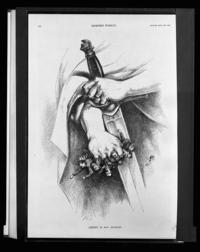 Liberty is Not Anarchy. Thomas Nast print in reference to the Haymarket bombing in May 1886 and the trial and conviction of the defendants on August 20. Published in Harper's Weekly it shows the hands of Columbia(?) holding, in her left hand, a sword labeled U.S., and in her right, a handful of anarchists. Illus. in: Harper's Weekly, v. 30, no. 1550 (1886 September 4), p. 564. Library of Congress Prints and Photographs Division, LC-USZ62-135065. |
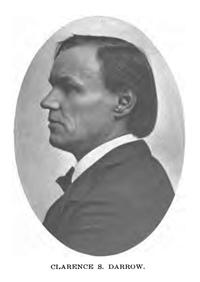 Clarence S. Darrow. Darrow's photo from the Proceedings of the Illinois State Bar Association published in 1906. |
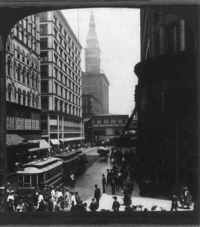 Madison Street, east toward the Lake from State Street c. 1905. Library of Congress Prints and Photographs Division, LC-USZ62-51778. |
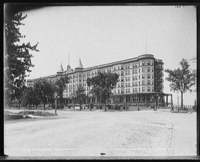 Chicago Beach Hotel c. 1900. Library of Congress Prints and Photographs Division, LC-D4-12621. |
 Liberty is Not Anarchy. Thomas Nast print in reference to the Haymarket bombing in May 1886 and the trial and conviction of the defendants on August 20. Published in Harper's Weekly it shows the hands of Columbia(?) holding, in her left hand, a sword labeled U.S., and in her right, a handful of anarchists. Illus. in: Harper's Weekly, v. 30, no. 1550 (1886 September 4), p. 564. Library of Congress Prints and Photographs Division, LC-USZ62-135065. |
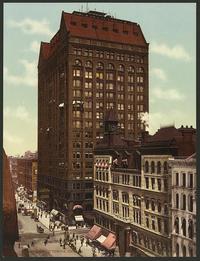 Masonic Temple, Chicago c. 1901. 22 stories high and located at the corner of Randolph and State Streets. Library of Congress Prints and Photographs Division, LC-DIG-ppmsca-18095. |
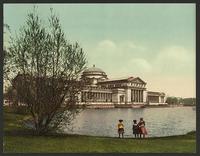 Field Columbian Museum, Jackson Park, Chicago c. 1901. Library of Congress Prints and Photographs Division, LC-DIG-ppmsca-18167. |
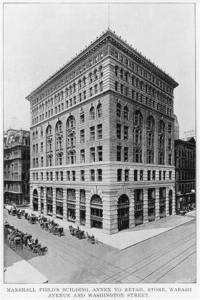 Marshall Fields Building in Chicago c. 1898. |
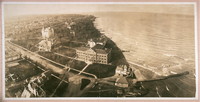 Bird's-eye view of Northwestern University c. 1907. Library of Congress Prints and Photographs Division, LC-USZ62-53414. |
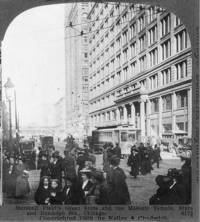 Marshall Field's and the Masonic Temple, State and Randolph Streets, Chicago c. 1909. Library of Congress Prints and Photographs Division, LC-USZ62-51792. |
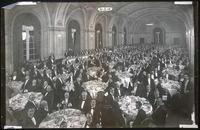 Banquet by Illinois State Bar Association for Justices of Supreme Court of Illinois. Held at the LaSalle Hotel, Chicago, October 30, 1909. Library of Congress Prints and Photographs Division. |
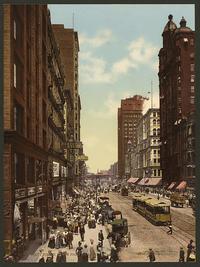 State Street north from Madison, Chicago c 1900. Library of Congress Prints and Photographs Division, LC-DIG-ppmsca-18098. |
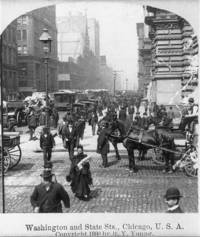 Washington and State Streets, Chicago c. 1900. Library of Congress Prints and Photographs Division, LC-USZ62-51771. |
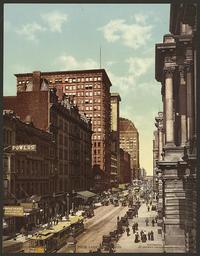 Randolph Street east from LaSalle Street, Chicago c. 1900. Library of Congress Prints and Photographs Division, LC-DIG-ppmsca-18099. |
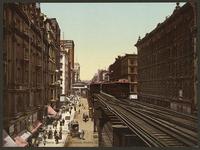 Wabash Avenue North from Adams Street, Chicago c. 1900. Library of Congress Prints and Photographs Division, LC-DIG-ppmsca-18100. |
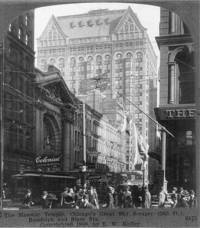 The Masonic Temple, Chicago's Great Sky Scraper (265 ft.), Randolph and State Streets. c. 1909. Library of Congress Prints and Photographs Division, LC-USZ62-51773. |
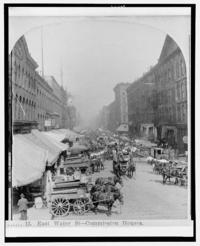 East Water Street - Commission Houses, Chicago c. 1898. Library of Congress Prints and Photographs Division, LC-USZ62-78621. |
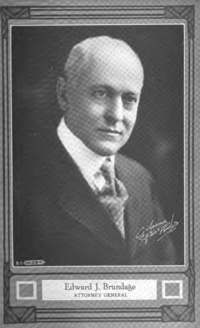 Edward J. Brundage. Edward J. Brundage was the Attorney General of Illinois from 1917 to 1925. Clarence Darrow faced Attorney General Brundage in court during several appeals including People v. Lloyd, 304 Ill. 23 (1922) involving the conviction of twenty members of the Communist Labor party for advocating the forceful overthrow of the government and People v. Bond, 281 Ill. 490 (1917) in which Isaac Bond, a black man, was convicted of murdering a white woman. |
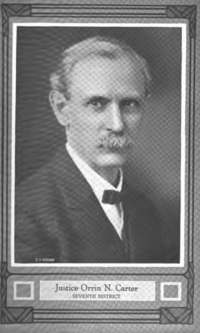 Justice Orrin Carter. From June to August 1920 Clarence Darrow and several other attorneys defended twenty members of the Communist Labor charged with violating an Illinois statute that made it unlawful to advocate reformation or overthrow of the existing form of government by violence or other unlawful means. The defendants were convicted and their conviction was affirmed by the Illinois Supreme Court in People v. Lloyd, 304 Ill. 23 (1922). Clarence Darrow recalled in his autobiography that on appeal before the Illinois Supreme Court "the chief justice of the court, Orrin Carter, wrote a vigorous dissenting opinion which breathed the spirit of the liberty of the individual. The governor, quoting from this opinion, then pardoned them before they spent a single day in prison." |
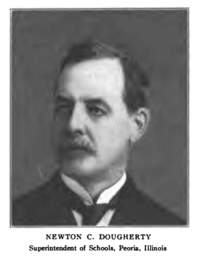 Newton C. Dougherty. In March 1915 Darrow and another attorney represented Newton C. Dougherty in a request for a pardon before Illinois Governor Dunne. Dougherty was convicted of forgery committed while he was the Superintendent of Schools for Peoria County had spent seven years in prison. Dougherty had faced 140 indictments but plead guilty to five indictments which amounted to $750 worth of forgery. Governor Dunne granted the pardon. Photo published in The Outlook in 1905. |
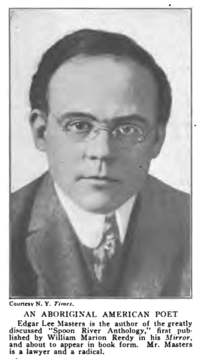 Edgar Lee Masters. Clarence Darrow and Edgar Lee Masters formed a law partnership in 1903 that lasted until 1911. However, they did not always get a long and the partnership was dissolved with animosity between them. Photo from Current Opinion (1915). |
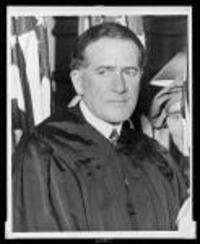 Judge Frank D. Comerford. Judge Comerford presided over an Illinois trial in 1920 in which Clarence Darrow and several other attorneys defended twenty members of the Communist Labor party who were charged with advocating the forceful overthrow of the government. The defendants were convicted and this was affirmed by the Illinois Supreme Court in People v. Lloyd, 304 Ill. 23 (1922). Library of Congress Prints and Photographs Division, LC-USZ62-123872. |
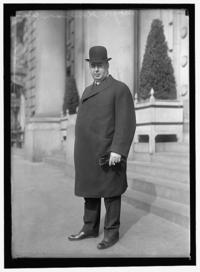 William Hale Thompson [between 1911 and 1917]. William Hale Thompson (1869 - 1944) served as the mayor of Chicago from 1915 to 1923 and 1927 to 1931. Known as "Big Bill" he was the last Republican to be elected mayor of Chicago. In 1923, Clarence Darrow helped defend Fred Lundin, a friend of Mayor Thompson, and twenty-three others who were accused of stealing more than a million dollars from the Chicago public schools. There appeared to be overwhelming evidence of guilt but Lundin and the others were found not guilty. During the Lundin investigation Mayor Thompson decided not to run for re-election. But the acquittal of Lundin and the other defendants allowed Thompson and his administration to escape without any convictions. This allowed Thompson to be elected mayor in 1927 because of Al Capone's support. This last Thompson administration was even more corrupt than his previous administrations and Thompson is widely viewed as being one of the most corrupt mayors in the history of the United States. Library of Congress Prints and Photographs Division, LC-DIG-hec-07050. |
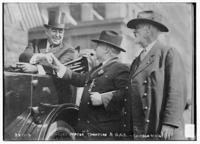 Mayor William H. Thompson & G.A.R. Veterans in Chicago. In 1915, William Hale Thompson (1869 - 1944) was elected mayor of Chicago and he served until 1923. Thompson was the last Republican to be elected mayor of Chicago. Known as "Big Bill" his administration became notorious for corruption. He would also be elected mayor again in 1927 and serve until 1931. Clarence Darrow would successfully defend several clients who were part of the Thompson administration. Thompson is widely viewed as being one of the most corrupt mayors in the history of the United States. The G.A.R. is the Grand Army of the Republic a fraternal organization for veterans of the Union Army who had served in the American Civil War. Library of Congress Prints and Photographs Division, LC-DIG-ggbain-21872. |
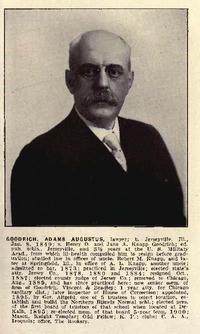 Adams Goodrich. In 1893 Clarence Darrow and several prominent Chicago attorneys including Adams Goodrich formed the law firm of Collins, Goodrich, Darrow & Vincent. Their law office was in the famous Rookery Building, a historic landmark located in the Loop community area of Chicago. Goodrich also served as an Illinois state judge. |
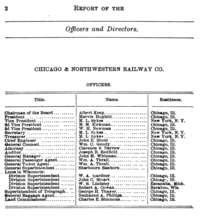 Report of the Officers and Directors. Excerpt from a report showing Clarence Darrow listed as an attorney with the Chicago & Northwestern Railway. From Biennial report of the Railroad Commissioner of the State of Wisconsin (1892). |
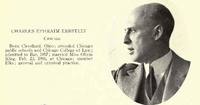 Charles Ephraim Erbstein. Charles Erbstein was a very successful criminal defense attorney in Chicago. He was also a radio pioneer and owner of the radio station WTAS. In 1924 Charles C. Healey, chief of police of Chicago, was indicted for malfeasance in office and as a conspirator in a plot to nullify anti-gambling laws. Others were also indicted. Clarence Darrow was associated with Erbstein during the Healey trial and several other cases. |
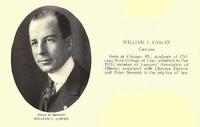 William L. Carlin. William Carlin was associated with Clarence Darrow in the law firm of Darrow, Sissman, Holly & Carlin. |
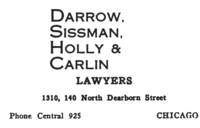 Darrow, Sissman, Holly & Carlin Lawyers. 1922 advertisement in Public Ownership published by the Public Ownership League of America. |
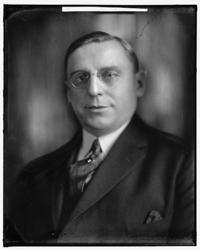 Anton Cermak. In 1903 Clarence Darrow served with several members of the Illinois Legislature who would later be important players in Illinois and Chicago politics. One was Anton (Tony) Joseph Cermak (1873 - 1933). Cermak was elected mayor of Chicago in 1931 ending the Republican Party's power in Chicago. On February 15, 1933 while Cermak was standing near President-elect Franklin D. Roosevelt who had just given a speech in Miami, Florida, an assassin named Giuseppe Zangara tried to shoot Roosevelt but he shot Cermak instead. Cermak was hit in the lung and seriously wounded. Several other people besides Cermak were also wounded. Accounts vary with some saying a woman died but others saying she was seriously wounded but survived. Cermak died on March 6. Zangara was later tried, convicted and executed. Library of Congress Prints and Photographs Division, LC-DIG-hec-21393. |
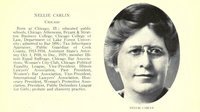 Nellie Carlin. Nellie Carlin was associated with Clarence Darrow's law firms for several years. According to a 1900 article "During her practice Miss Carlin has been connected with the firm of Darrow, Thomas & Thompson, who speak in the highest praise of her ability." In 1900 she formed a law partnership with another woman female attorney. According to another source, Carlin practiced law with Darrow's firms from 1895 to 1910. Nellie Carlin went on to hold several prominent positions. At one time she became the second president of the Women's Bar Association of Illinois. In 1915 she was appointed Public Guardian of Cook County for children. She ran for municipal judge in 1914 and in 1917, she was appointed an assistant state's attorney. Photo from the Bench and Bar of Illinois, 1920. |
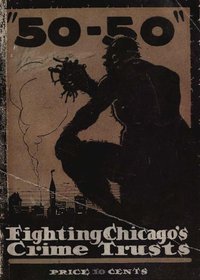 50 - 50 Fighting Chicago's Crime Trusts by Henry B. Chamberlin. Cover from book containing a description of an arson investigation in the first chapter. Clarence Darrow defended at least one of the defendants arrested and tried for arson as part of this investigation. Full-text available above. |
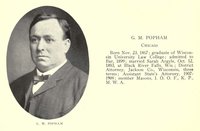 George Popham. Around 1918 Clarence Darrow expanded his law firm by bringing in George Popham who had previously been an assistant state's attorney in Illinois. Sometime in 1922 Popham forged a will for a client. An opposing attorney called Peter Sissman in Darrow's firm to inform them but Sissman could not believe it so he did not tell Darrow. Darrow went to court in the matter and the forgery became known and created a scandal and greatly upset Darrow. According to Irving Stone in his biography Clarence Darrow For the Defense, Popham called another attorney to his office, showed him a revolver he had in his desk and asked the attorney to testify on his behalf or Popham said he would "blow my brains out." When informed of this, Darrow said "You go back and tell Popham that's the best thing to do but not to do it in the office; he's made enough mess around here." |
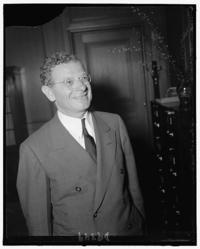 Sidney Hillman. Sidney Hillman (1887 - 1946) was president of the Amalgamated Clothing Workers of America from 1914 to 1946. Clarence Darrow worked for a time as counsel to the Amalgamated Clothing Workers of America which was formed in 1914. Library of Congress Prints and Photographs Division, LC-DIG-hec-28923. |
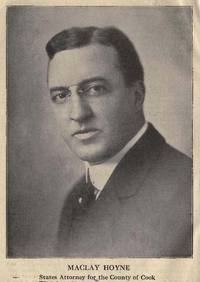 Maclay Hoyne. Maclay Hoyne was an Illinois State Attorney for Cook County. Clarence Darrow faced Hoyne in several trials and during several appeals. Photo from 50 - 50 Fighting Chicago's Crime Trusts by Henry B. Chamberlin. |
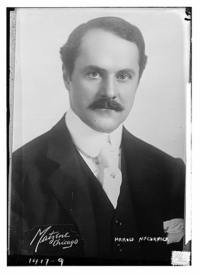 Harold F. McCormick. Harold Fowler McCormick (1872 - 1941) was the president of the International Harvester Company. In 1921 Clarence Darrow worked with two other lawyers including George A. Cooke, former Chief Justice of the Illinois Supreme Court, while representing Harold F. McCormick in divorce proceedings with his wife Edith Rockefeller McCormick who was the daughter of John D. Rockefeller. The couple divorced on December 28, 1921 in Chicago. |
 Rookery Building. In 1893 Clarence Darrow and several prominent Chicago attorneys formed the law firm of Collins, Goodrich, Darrow & Vincent. Their law office was in the famous Rookery Building, a historic landmark located in the Loop community area of Chicago. The building is considered a masterpiece of Burnham and Root, one of the most famous architectural firms of the nineteenth century. Photo from the Photographic History of the World''s Fair and Sketch of the City of Chicago (1893). |
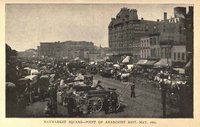 Haymarket Square. Location where the Haymarket bombing took place on May 4,1886. |
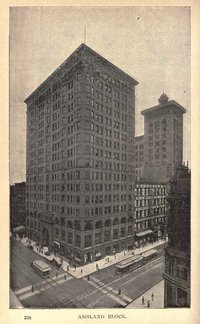 Ashland Block, Chicago. Ashland Block, located on the northeast corner of Clark and Randolph streets, contained several prestigious Chicago law firms. Clarence Darrow had offices in this building for many years. |
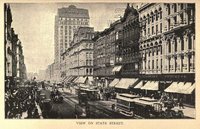 View on State Street. |
 Chicago's Water Front c. 1913. Library of Congress Prints and Photographs Division, LC-USZ62-126464. |
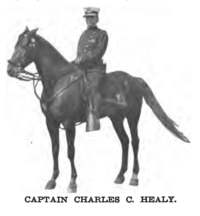 Charles C. Healy. In 1917 Maclay Hoyne Illinois State Attorney for Cook County began investigating corruption in Chicago. On October 23, 1924 Hoyne's investigations snared Charles C. Healy (sometimes spelled Healey), chief of police of Chicago, who was indicted on two charges: malfeasance in office and as a conspirator in a plot to nullify anti-gambling laws. Others were also indicted including a detective sergeant and an underworld bail bondsman named Billy Skidmore. Clarence Darrow helped defend Healey who was elderly. To the surprise of many Healey and the others were acquitted. Darrow was associated with Charles Erbstein a very successful criminal defense attorney in Chicago during the Healey trial and several other cases. Erbstein was also a radio pioneer and owner of the radio station WTAS. |
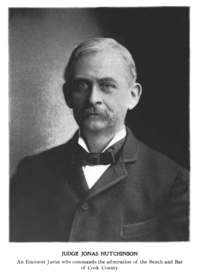 Jonas Hutchinson. Jonas Hutchinson (1840 - 1903) was the Corporation Counsel for the city of Chicago from 1889 to 1891. He left that position when he was elected as a judge to replace the position held by John Peter Altgeld who resigned to run for governor of Illinois. Clarence Darrow served under Hutchinson as one of the Assistant Corporation Counsels. Photo from the Illinois Political Directory (1899). |
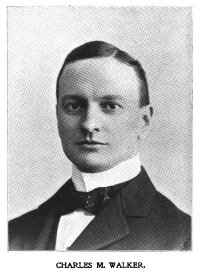 Charles M. Walker. Charles M. Walker was chosen to serve as corporation counsel for the city of Chicago by Mayor Carter Henry Harrison IV. He faced Clarence Darrow in several trials and he was co-counsel with Darrow in at least one case. Walker was later a circuit court judge in Chicago for 17 years. |
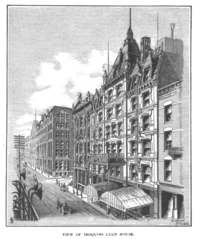 Iroquois Club House. As early as 1890 Darrow was a member, along with John Peter Altgeld, of the Iroquois Club in Chicago. It was formed to create "a substantial society in the form of a social club that should be representative of progressive democratic principles..." Other members who would figure in Darrow's public were DeWitt C. Cregier, future mayor of Chicago, and Stephen S. Gregory, one time president of the American Bar Association. Picture from the History of Chicago (1886). |
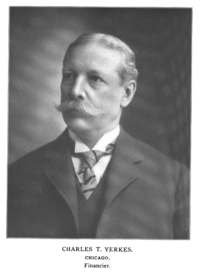 Charles T. Yerkes. Charles Yerkes (1837 - 1905) was a financier who was born in Philadelphia and played a major role in developing the mass-transit systems in Chicago and London. In Chicago in 1897 Yerkes supported a bill that would extend the street-car franchise to 50 years instead of 30 years thus greatly benefitting Yerkes. Clarence Darrow wrote in his autobiography "Of course Mr. Yerkes had competent lawyers, as all rich people have. He employed the best and most skilful lobbyists to work for his bill. He managed to get control of the House and the Senate, the bills were passed, and up to the governor for veto or approval. Every one wondered what Altgeld would do. No one ever doubted his integrity, but his enemies hated him the more for that. Altgeld owed nothing to the forces that were against Mr. Yerkes." In the end Altgeld vetoed the bill. Yerkes Observatory at the University of Chicago is named after Charles Yerkes because he funded the building of a 40 inch refracting telescope that was completed in 1895. |
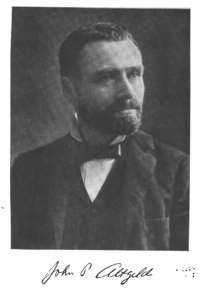 John Peter Altgeld. On March 12, 1902 John Peter Altgeld was just finishing a speech at a pro-Boer mass meeting at the Joliet Theater in Joliet, Illinois when he became dizzy and had to be assisted from the stage. He was taken to a hotel and his condition did not appear to be too serious, but shortly before midnight he became unconscious and died from a cerebral hemorrhage. Upon hearing the news, Clarence Darrow raced to Joliet. During a eulogy at Altgeld's funeral Darrow said: "My dear, dead friend, long and well have we known you, devotedly have we followed you, implicitly have we trusted you, fondly have we loved you. Beside your bier we now must say farewell. The heartless call has come, and we must stagger on the best we can alone. In the darkest hours we will look in vain for your loved form, we will listen hopelessly for your devoted, fearless voice. But, though we lay you in the grave and hide you from the sight of man, your brave words will speak for the poor, the oppressed, the captive and the weak; and your devoted life inspire countless souls to do and dare in the holy cause for which you lived and died." |
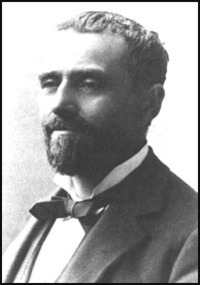 John Peter Altgeld. On March 12, 1902 John Peter Altgeld was just finishing a speech at a pro-Boer mass meeting at the Joliet Theater in Joliet, Illinois when he became dizzy and had to be assisted from the stage. He was taken to a hotel and his condition did not appear to be too serious, but shortly before midnight he became unconscious and died from a cerebral hemorrhage. Upon hearing the news, Clarence Darrow raced to Joliet. During a eulogy at Altgeld's funeral Darrow said: "My dear, dead friend, long and well have we known you, devotedly have we followed you, implicitly have we trusted you, fondly have we loved you. Beside your bier we now must say farewell. The heartless call has come, and we must stagger on the best we can alone. In the darkest hours we will look in vain for your loved form, we will listen hopelessly for your devoted, fearless voice. But, though we lay you in the grave and hide you from the sight of man, your brave words will speak for the poor, the oppressed, the captive and the weak; and your devoted life inspire countless souls to do and dare in the holy cause for which you lived and died." |
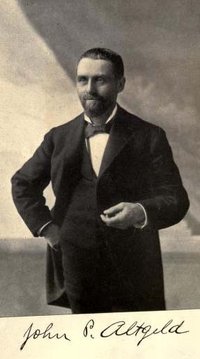 John Peter Altgeld. John Peter Altgeld (1847 - 1902) was Clarence Darrow's mentor and one of the most important influences in Darrow's life and career. Altgeld was born in Germany and his family emigrated to the United States when he was a few months old and settled in Ohio. During the Civil War, he joined the Union Army at the age of sixteen and fought in an infantry unit until the end of the war. During the war he contracted a fever and nearly died. After the war Altgeld attended a seminary in Ohio for a brief period but left and walked from Ohio to Missouri. In Missouri, he studied law and became a lawyer in 1869 and was elected the state's attorney for Andrew County, Missouri in 1874. In 1875, Altgeld moved to Chicago and set up a prominent law practice. He also was very successful in real estate and ten years later his wealth was estimated at $1,000,000. In 1886 Altgeld was elected to the Cook County Superior Court as a Democrat and served on the bench until 1891. Altgeld was elected governor of Illinois in 1892 and served from 1893 to 1897. He was the first foreign-born governor of the state. In his autobiography, Clarence Darrow recounts how while he was still living in Ohio he first became aware of Altgeld. "Judge Richards, a police judge in Ashtabula, gave me my first sane idea of crime and criminals. He gave me a little book, Our Penal Code and Its Victims, by Judge John P. Altgeld, of Chicago, which was a revelation to me. This book and the author came to have a marked influence upon me and my future." The actual title of the book is Our Penal Machinery and Its Victims and it so influenced Darrow that sometime after arriving in Chicago in 1888 he went to meet Altgeld. Darrow and Altgeld, who was at this time a judge, quickly became good friends and Darrow looked up to Altgeld perhaps more than any other person in his life. This photo is from Altgeld's book Live Questions published in 1899. |
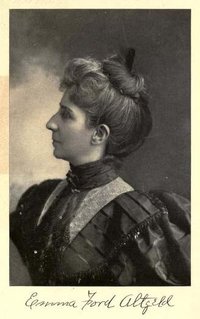 Emma Ford Altgeld. Emma Ford Altgeld (1849 - 1915) was the wife of John Peter Altgeld who served as governor of Illinois from 1893 to 1897. Altgeld, who was Clarence Darrow's mentor, died in March 1902. In November 1902 Clarence Darrow was elected to the Illinois House of Representatives. In April 1903 Darrow voted against a bill that would have appropriated $5,000 for Emma Altgeld. Darrow explained his opposition to the bill: "No man ever lived whom I respected and loved outside my blood relations as I did John P. Altgeld. There is no woman more worthy of respect than the woman who is to be relieved in this bill. I know, and we all know, what John P. Altgeld sacrificed for the State of Illinois and for his devotion to duty as he saw it and as he believed it to be; and no man ever followed his duty more devotedly than did John P. Altgeld. A few weeks ago I voted against a bill to erect a monument to the memory of a good and great woman who lived and died in Illinois (Frances E. Willard). I voted against the appropriation to give $5,000 to the Swedes and Finns who doubtless were in need. I do not intend to vote against all appropriations ... But I do not see how we have the right to vote the money that must be paid by the property holders of this State, great and small, to any private individual, no matter how much I respect them, no matter how high they stand in the common esteem. Much as I regret it, I believe that this sort of legislation is not proper legislation and that there is nothing for me, at least, to do but to vote no on this bill." |
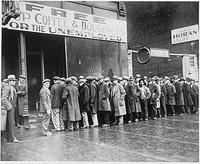 Unemployed Men Queued Outside a Depression Soup Kitchen Opened in Chicago by Al Capone. National Archives and Records Administration, ARC identifier 541927. |
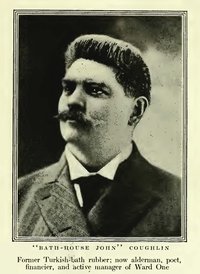 "Bathhouse" John Coughlin. "Bathhouse" John Coughlin (1860 - 1938) was an alderman in Chicago's First Ward from 1892 or 1893 until he died in 1938. Coughlin and alderman Michael "Hinky Dink" Kenna ran Chicago's First Ward, which included the notorious "Levee" district, for about 45 years. During this time period Chicago had a well earned reputation for corruption and Coughlin and Kenna were legendary for the way they used their political position to sell protection to gambling and prostitution houses and engage in election fraud. Coughlin was born in Chicago to Irish immigrants. He earned the nickname "Bathhouse" because at age 19 he got a job as a towel boy and errand runner in a Turkish bathhouse in Chicago. In 1894 an underling named Billy "The Clock" Skakel was dissatisfied with his take from Coughlin so he decided to run against Coughlin in the upcoming election for alderman. Coughlin was the candidate for the Democratic Party so Skakel formed the Independent Democratic Party so he could get on the ballot. Coughlin became worried when it looked like Skakel might win so he went to Mayor Hopkins for help. Hopkins called Skakel in and asked him to withdraw but Skakel refused. Coughlin then had some of his lawyers and Moses Salomon, the state senator for the First District, look for a way to keep Skakel out of the race. A week before the election they found a city law that prohibited anyone convicted of a crime from holding a municipal office. Skakel had been arrested and fined some years previously for gambling so they took this information to the election board. The board was controlled by Mayor Hopkins' people and they removed Skakel's name from the ballot without granting him a hearing. The next day Skakel, with several attorneys including Clarence Darrow, went before a judge to argue that removing Skakel from the ballot was illegal. The judge agreed and Skakel was put back on the ballot. The election was held on April 3, 1894. Because of the contest between Skakel and Coughlin there was a great deal of violence with three people being shot but none died. Coughlin ended up winning the election. Skakel was the paternal great-uncle of Ethel Kennedy. |
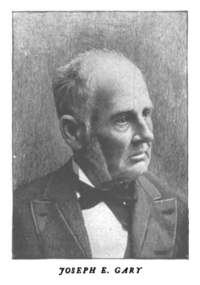 Judge Joseph E. Gary. When Governor Altgeld pardoned the remaining Haymarket defendants he sharply criticized Judge Gary in a report he issued. Clarence Darrow in his autobiography The Story of My Life wrote "I feel that Governor Altgeld was wrong in laying all the blame to Judge Gary, the trial judge. Undoubtedly his rulings were biased and unfair, but where is the man who, under the lashing of the crowd, is not biased and unfair? If Judge Gary erred, the Supreme Court was still more to blame ... To severely blame Judge Gary meant blaming a judge for not being one in ten thousand, and few men can be that and live." Photo from Elisha Benjamin Andrews, The History of the Last Quarter-Century in the United States, 1870-1895, Volume 1 (C. Scribner's, 1896). |
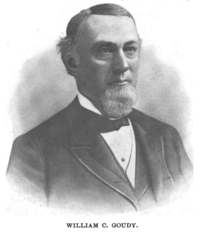 William C. Goudy. William C. Goudy (1824 - 1893) was the general counsel for the Chicago & Northwestern Railway Company in 1891 when Clarence Darrow accepted a part-time position in the legal department of the railroad. Goudy was also a prominent Democrat in Illinois. Goudy was also a founder and the first president of the Chicago Bar Association. According to one account, in "April of 1893 . . . William C. Goudy collapsed at his desk of an apparent heart attack in the legal department of the Chicago & Northwestern Railroad Company as he was working with his assistant, Clarence Darrow." Richard C. Cortner, The Iron Horse and the Constitution: The Railroads and the Transformation of the Fourteenth Amendment 125 (1993). |
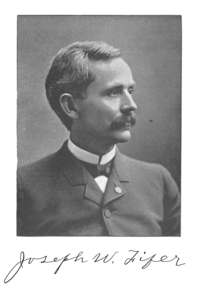 Joseph W. Fifer. Joseph Wilson Fifer (1840 - 1938) served as the Republican governor of Illinois from 1889 to 1893. Fifer was defeated in the 1892 election by John Peter Altgeld. |
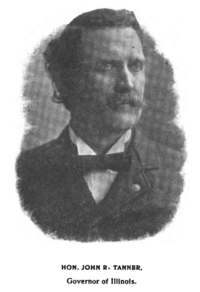 John R. Tanner. John R. Tanner defeated John Peter Altgeld in the 1896 election for Governor of Illinois. |
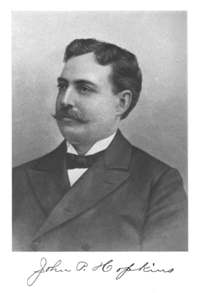 John P. Hopkins. John Patrick Hopkins (1858 - 1918) was the Democratic mayor of Chicago from 1893 to 1895. He was the first of nine Catholic Irish-American mayors of Chicago. In March 1894 Clarence Darrow became involved in political battle in Chicago. Darrow and other lawyers represented Billy "The Clock" Skakel who was trying to defeat his boss "Bathhouse" John Coughlin in an election for alderman in Chicago's First Ward. The First Ward was notorious for corruption. When Skakel looked like he had a chance to win, Coughlin got the election board, controlled Mayor Hopkins' people, to remove Skakel's name from the ballot without granting him a hearing. The board removed Skakel because he had been arrested and fined some years previously for gambling. Darrow and the other lawyers went before a judge to argue that removing Skakel from the ballot was illegal. The judge agreed and Skakel was put back on the ballot. Coughlin ended up winning the election that was held on April 3, 1894. |
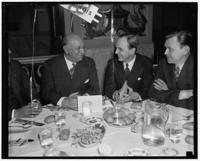 Governor Henry Horner (seated at left). Henry Horner (1878 - 1940) was the 28th Governor of Illinois. He served from 1933 until he died in office in 1940. In 1932 Clarence Darrow came out of retirement to defend a seventeen year old named Russell McWilliams who was charged with first-degree murder for killing a street car conductor. McWilliams was seventeen years and eleven days old on August 29, 1931, the date of the homicide. He pled guilty on October 26, 1931 and two days later the presiding judge heard evidence in aggravation and mitigation of the crime and then sentenced McWilliams death. The defense twice got the conviction reversed and remanded. Darrow, William H. Holly and other attorneys represented McWilliams during his second appeal. Darrow argued before the Illinois Supreme Court on February 16. The defense successfully argued that the trial court erred when it denied a change of venue (People v. McWilliams, 350 Ill. 628, 183 N.E. 582 (Ill. 1932)). The Illinois Supreme Court reversed and remanded the case. Darrow then helped defend McWilliams during his third murder trial. Despite Darrow's pleas for mercy McWilliams was again sentenced to death. Darrow later traveled to Springfield to plead before the Illinois State Board of Pardons and Parole to recommend clemency before the Governor. In April 1933 Governor Horner commuted McWilliams' sentence to 99 years in prison. The governor announced his decision on April 18, Darrow's birthday. McWilliams was released on parole in 1951. Photo is of Governor Henry Horner on the left at luncheon today in the Mayflower Hotel in Washington, D.C. Library of Congress Prints and Photographs Division, LC-DIG-hec-22025. |
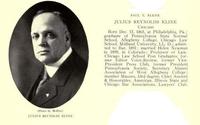 Julius Reynolds Kline. Julius Reynolds Kline was an attorney in Chicago. After Kline died on December 20, 1926 the New York Times reported that at one time Kline had been associated with Clarence Darrow in the practice of law. Kline was often referred to with the title "Colonel" because of his many years in the Naval militia and Illinois National Guard. |
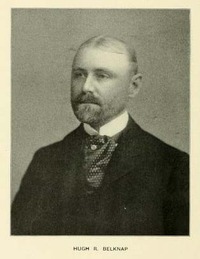 Hugh Reid Belknap. During the historic 1896 election, Governor John Peter Altgeld was running for re-election and he persuaded a reluctant Clarence Darrow to run for Congress. Darrow did not actively campaign for himself because it was thought the seat he was running for was safely Democratic. Instead he traveled to other districts to campaign for other Democratic candidates. But Altgeld lost the governorship and Darrow lost his race. The official vote was 22,075 votes for the Republican Hugh Reid Belknap and 21,485 votes for Darrow. |
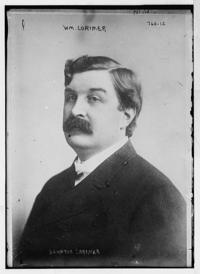 William Lorimer. William Lorimer (1861 - 1934) was born in Manchester, England. His family immigrated to the United States in 1866, first settling in Michigan and in 1870 they moved to Chicago. He was self-educated and at age ten he was apprenticed in the trade of sign painter and also worked in the packing houses and for a street railroad company. He worked his way up from poverty and eventually became successful in real estate and as a builder and brick manufacturer. He was elected to the U.S. Representative from the State of Illinois and served from 1895-1901 and 1903-1909. In 1909 Lorimer sought a seat in the United States Senate and this was when senators were chosen by the state legislature. Lorimer was chosen after months of deadlock in the Illinois legislature. Nearly a year later, Lorimer asked the Senate to investigate charges by the Chicago Tribune charged that he had obtained his seat through bribery and corruption. After much debate the Senate dropped the case in March 1911. But public outrage helped push the Senate to approve an already pending constitutional amendment providing for direct popular election of senators. Additional charges of corruption led the full Senate in July 1912 to declare Lorimer’s 1909 election invalid. In May 1913 the Seventeenth Amendment providing for direct election of U.S. senators was ratified. Lorimer was the last senator removed from office for corrupting a state legislature. In 1914 Lorimer was charged with criminal conduct after a bank he started failed. Clarence Darrow defended Lorimer early in the case but not when the case went trial in 1916. |

